Known more for filming nocturnal activities at music festivals and concerts, Dod Morrison turns his lens from the jet set to the badger sett. Photos and story by Dod Morrison.
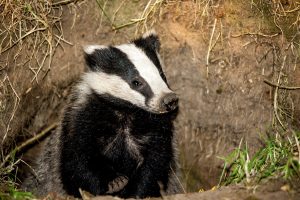 The word Badger is said to derive from the French word Becheur meaning digger. Badgers have been present in the British Isles for at least 300,000 – 400,000 years.
The word Badger is said to derive from the French word Becheur meaning digger. Badgers have been present in the British Isles for at least 300,000 – 400,000 years.
Badgers live in complex underground burrow systems called setts, which can accomodate a group of six to ten individuals.
They are nocturnal animals, emerging from their setts soon after dusk and sniffing the air for danger before going about their activities.
This much loved animal is subject to persecution which stems back to the 70s when some badgers were found to be infected with TB. Some people thought that this could be passed on to cattle, and to combat this they starting gassing setts to keep the population of badgers down.
Even though there is no hard evidence that this is true, culling is still going on in some counties in England in 2016.
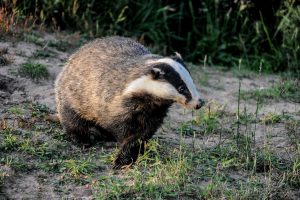 Road traffic is another problem for these creatures with as much as 40,000 being killed every year.
Road traffic is another problem for these creatures with as much as 40,000 being killed every year.
This is partly because badgers tend to habitually follow the same paths. So, if a road is built near a sett, the badgers just do as they normally do, placing them at the mercy of traffic.
On some new roads, however, badger tunnels are built underneath.
Imagine my delight when I was told where there was a sett and a good chance to see some of them up close and personal.
On arrival at this location, I put out some peanuts near where I thought they might appear.
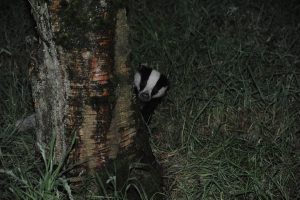 After sitting for about a hour, we could see something moving about in the gorse and then slowly we could see the familiar black and white stripes appearing over the ridge.
After sitting for about a hour, we could see something moving about in the gorse and then slowly we could see the familiar black and white stripes appearing over the ridge.
My heart skipped a beat and I started snapping away.
It looked up and I stopped and waited a few minutes until it got used to me, and then took more pics. I couldn’t believe how big it actually was.
Another smaller one appeared further down the gorse from a different hole and came out into the open and was even closer. Wow! I was hooked. We watched them for about 20 minutes.
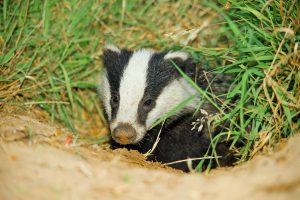 Over the next few months I visited them on several occasions.
Over the next few months I visited them on several occasions.
It is such a buzz when you see a head popping out of the sett and especially when it is one of the little cubs who are still quite shy and not as bold as the older ones.
When you see them out in the open away from the sett just milling about in the grass, it is joy to behold and fascinating to watch.
 They just wander around sniffing the air and then, noses to the ground, sniffing out earthworms.
They just wander around sniffing the air and then, noses to the ground, sniffing out earthworms.
Sometimes they just run around enjoying themselves.
.
.
.

Near badgers setts there is often have a tree they scratch.
To see them this near is great – especially when one of them plays peek-a-boo with you.
Not many people will see these wonderful animals in their natural habitat so it was pleasure and a privilege to see them.
.
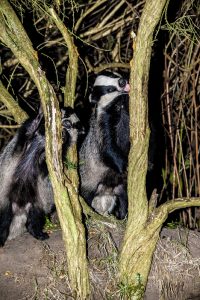 My first visit in September proved to be my most fruitful and exciting yet.
My first visit in September proved to be my most fruitful and exciting yet.
They were on top form, climbing up the small tree stems, coming real close for the next two hours and general just larking about.
There is one young cub who is very shy.
I have caught sight of his head, but he rarely ventures out.
However, tonight I believe I finally captured him.
This was a magical moment as were all the sightings of these wonderful animals.
All photography © Dod Morrison – all rights reserved.
- Comments enabled – see comments box below. Note, all comments will be moderated.
Great stuff Dod, these are superb pictures. Since they started work on the AWPR near us I’ve seen too many badger casualties, as you say they’re creatures of habit and digging up their routes and homes creates havoc. They are amazing animals, it’s a tragedy that we’re more likely to see them dead than alive.